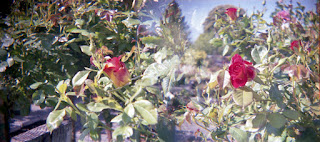The short answer on the Viddy is, no... I did not correct the light leak.
Here you can see the streaks across the negatives, the light was still leaking in one of the chambers that holds the film rolls.
The camera's design should not allow light leaks from the door side anyway, but I had triple taped it just in case and still had the light leak. After much poking and prodding with my flashlight and a dummy roll of film, I determined that that the only other place for light to leak in would be where the handles hold the rolls. I realized that when I turn the knob to advance the film, I loosened up the knob, which meant light could get where the knob turns. In case anyone out there decided to google Viddy light leak, here is what I'm talking about:
The round cardboard on the knob is supposed to sandwich against the camera body, however I pulled the knob while the film was loaded and loosened it up. The top knob is sandwiched properly, the bottom knob is loos and you can see my finger through the other side. For anyone out there with a Viddy, make sure the rounds are sandwiched tightly when you load the film!
The light leak did not ruin the entire roll of film, but several images do have streaks across them, and it is difficult to be 100% sure if my exposure calculations were correct, or if they are fogged by the light too much to know. I can say that my exposures are at least much closer to correct than they were on my first outing, so I'll continue with how I have the calculator set up.
Some examples from the Viddy, second test, all shot on Ilford IP5 400, and using a pinhole exposure calculator plus compensating for reciprocity failure.
35 second exposure, I was hoping to see a bird land on the house during the exposure, but no such luck.
97 second exposure - the wind picked up during my outing so I decided to use it for effect, this is mountain bluet blowing in the breeze on the border of the meadow.
97 second exposure - this is the most properly exposed looking shot on my roll, and the lease fogged, so I believe the calculations I'm using are decently accurate. The meadow is quite fuzzy due in part to the wind. Also there were actually several swifts flying through the frame during the exposure, however they were too fast to show up on my film.
And now onto the Graflex!
Upon arriving home, I headed straight to the laundryroom/darkroom to develop the Graflex roll. I was absolutely thrilled to see perfect rectangles of nicely exposed negatives, and then I had to wait (im)patiently for the negs to dry before I could scan them. Overall I think the exposures are pretty close to properly exposed, although they are all a bit dark even with my calculations compensating for reciprocity failure. Many of these exposures were done with just counting in my head rather than using a timer... in future shooting, I suppose I can err on the side of longer exposures. (Again I shot on Ilford XP5 400)
5 Seconds (or so) Here are the swift houses in the meadow, again I was hoping for a bird to land on the house while exposing the film. They landed before and after, but not during. Pesky buggers.
5 or 14 seconds ? (I missed writing one exposure in my notebook, so I don't know which time goes with which frame) - I lowered the camera angle to catch the long blades of grass blowing in the wind.
14 seconds - This is the mountain bluet blowing in the breeze.
5 Seconds - Though it is small in the frame, I did manage to photograph a bird with a pinhole camera.
The negatives from the Graflex show little to know signs of light leaks, though the edges of all the negs had little "hairs", which tells me I need to clean the dust out of the roll back before I load the next roll of film. The exposures are pretty close to perfect, and the clarity is relatively good. All in all, I call the pinhole conversion project a success, and I'm looking forward to lugging this beast along with me on more outings.
















































